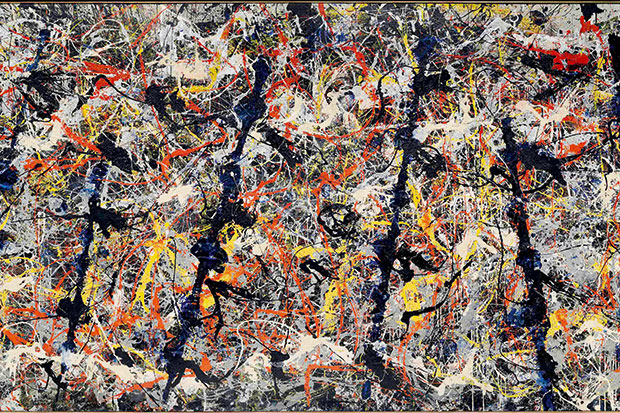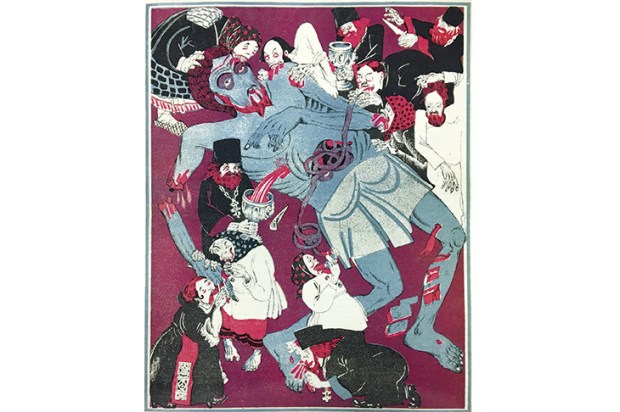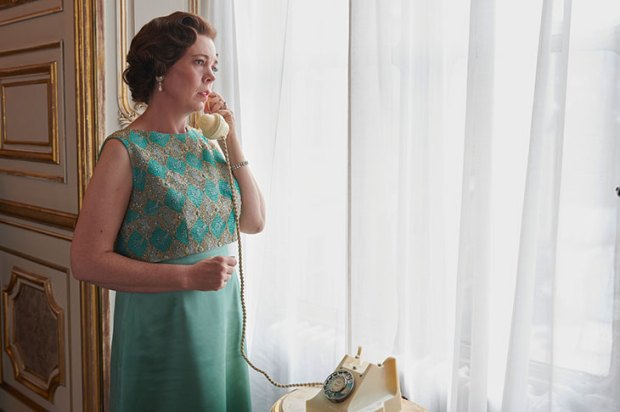‘At last,’ wrote Patrick Heron, a British painter, in 1956, ‘we can see for ourselves what it is to stand in a very large room hung with very large canvases by Jackson Pollock, Willem de Kooning, Mark Rothko, Clyfford Still, Franz Kline and others.’
Just over 60 years later, we, too, can stand in a series of grand galleries at the Royal Academy’s Abstract Expressionism and see what Heron saw, and much more.
He was at the (greatly anticipated) first showing of those fabled American artists in Britain. Since then, they have frequently been exhibited individually, but there has been just one collective show of the movement. Now Pollock, de Kooning and co. are back in town. Cumulatively, the result is majestic, exhilarating and visually overpowering.
Elusive, too. Ab Ex, as it is — more or less affectionately — known for short, was the Moby-Dick of modernist art. Several of the artists associated with it were, like Herman Melville, on a self-conscious quest for masterpieces. Strangely, the novel — published 1851 — seems to contain a vision of avant-gardism as it was to flourish in Lower Manhattan a century later. Early on, the narrator Ishmael encounters a canvas lurking in the gloom of the Spouter-Inn in the whaling port of New Bedford: ‘a long, limber, portentous, black mass of something’ which hovered above ‘three blue, dim, perpendicular lines floating in a nameless yeast’. The critic Robert Hughes rather unkindly suggested that either Mark Rothko, Barnett Newman or Clyfford Still must have got there ahead of Ishmael and his Polynesian companion Queequeg.
However, the most intriguing point about this account is not that it reads like an uncanny foretelling of Ab Ex. It’s how much Ishmael turns out to like the picture. ‘There was a sort of indefinite, half attained, unimaginable sublimity about it, that fairly froze you to it, till you involuntarily took an oath with yourself to find out what that marvellous painting meant.’ Actually, that may be just how you respond as you walk around the RA.
One of the problems facing the organisers of the exhibition is that abstract expressionism is hard both to define and locate. It is, as the name suggests, abstract and expressive — except when it is neither of those. At first sight, Jackson Pollock’s ‘Blue Poles’ (1952) — one of the show-stoppers of the exhibition — appears to be both.
It is an electrifying sight, with flickering skeins of paint criss-crossing like the neural pathways of the brain and the dark blue shadows of the title — like spears, totems or military standards — falling across the whole. This huge work crackles with such energy, is so crammed with eye-filling beauties, that it takes you over. It would be as difficult to put into words just what it means as it was for Ishmael to decipher the obscure masterpiece of the Spouter-Inn. Nonetheless, Pollock probably didn’t intend it to be purely abstract.
Some critics insisted that the power of Ab Ex was purely formal: to do with colour, line and space. The artists took the opposite view. The subject, de Kooning once said, is a glimpse — which is what his ‘Villa Borghese’ (1960) is like. It seems to show fleeting fragment of experience — sky, perhaps, and moving vegetation — on a canvas of heroic dimensions. Rothko and Adolph Gottlieb wrote a letter to the New York Times in 1943, insisting that ‘the subject is crucial and only that subject-matter is valid which is tragic and timeless’. Rothko later said that he was interested only in expressing ‘basic human emotions — tragedy, ecstasy, doom and so on’.
It is the tragic doominess of the abstract expressionists that puts some people off. Robert Rauschenberg, an influential member of the next generation of American artists and the subject of an exhibition at Tate Modern in December, told me that this approach bothered him as a young man: ‘Paint — which is an innocent material — having to be muddled through insistent emotional qualities just to express someone’s unhappiness’.
The tension between deep meaning and what can be done with bucketfuls of paint is part of the push-pull of the movement — if that is what it was (David Anfam, co-curator of the RA exhibition, prefers to term it a ‘phenomenon’). Traditionally, Ab Ex is seen as a style that flourished in New York in the mid-20th century. Art historically, it was made up of, first, abstraction derived from predecessors such as Kandinsky and Mondrian (the latter was resident in New York in the 1940s, and actually recommended Pollock to Peggy Guggenheim as a promising up-and-coming painter). Secondly, there was expressive brushwork from, among other places, German expressionism. Lastly, the unconscious, the particular hunting-ground of the surrealists, many of whom were also exiled in 1940s New York.
Put all this together and the result was Ab Ex: lots of paint, loads of looming significance. There were, however, newly added ingredients. One of which was scale. The canvases at the RA are often so large you feel you could step right into them. Instead of being a little window through which you look at the world, they envelop you.
That is true of ‘Blue Poles’, and of most of the paintings in the gallery filled with canvases by Clyfford Still. This is, perhaps, for a London audience, the biggest revelation of the exhibition. Of the great abstract expressionists, Still is usually the most elusively Moby Dick-like, since much of his work is on show in Denver, Colorado — not quite the ends of the earth in art world terms, but close.
Like Rothko and Newman, Still aimed for the sublime. His paintings have the feeling of high peaks and ravines rising into infinity like an ancient Chinese landscape. Still’s paintings aren’t landscapes, but the sensuous oil pigment and the sheer size act on you a bit like jagged crags and tumbling streams.
There’s something physically appealing about paint — Damien Hirst called it ‘yumminess’ — and the best of Ab Ex art has it to a spectacular degree. Gillian Ayres, herself a British abstract expressionist for a while in the 1950s, has talked about letting the paint itself behave like mist and mountains.
One of the problems of turning Ab Ex into an exhibition is: where do you stop? If it was a phenomenon rather than a movement, it was a highly amorphous one. In many ways American Ab Ex was part of an international wave. Patrick Heron, in later years, was a doughty advocate of the prior claims of British abstraction to certain innovations. There were also some notable French exponents of a very similar mode, such as Pierre Soulages.
Then there is the matter of when it began and ended. The RA show contains younger and more peripheral members of the group, such as Robert Motherwell, Sam Francis — who lived largely in Paris — and Joan Mitchell — all of whom score with show-stopping paintings. The Mitchell, ‘Salut Tom’, dates from 1979, which is a good while after the usual end date for Ab Ex. But, arguably, it still represents a continuation.
Even if you confine its limits to the borders of the United States, there is the question of medium. At the RA there are abstract expressionist sculptures and even some photographs of such things as moving lights or patches of lichen, by Aaron Siskind, Barbara Morgan and others. These look quite like Jackson Pollocks without the paint, which neatly demonstrates one of the paradoxes of the subject: there’s no such thing as abstraction because somewhere in the world there will be an equivalent to any mark a painter can make.
On the other hand, paint can make those marks so much more beautifully, and, in these pictures, with so much élan. Recently, I quoted Michelangelo Pistoletto’s suggestion that arte povera was the last art movement; that may be correct. But abstract expressionism, despite those photos and sculptures, was surely the last great movement that was basically all about painting. Sixty, 70, 80 years later it still looks wonderful. All kinds of qualifications can be made, but there remains something hugely impressive about the energy, ambition and sheer pizzazz of Pollock, Newman, de Kooning, Rothko and Still. The Americans really were very good at this. It’s not hard to understand why Heron was looking forward so eagerly to his first sight of their work.
The post American beauty appeared first on The Spectator.
Got something to add? Join the discussion and comment below.
Get 10 issues for just $10
Subscribe to The Spectator Australia today for the next 10 magazine issues, plus full online access, for just $10.
You might disagree with half of it, but you’ll enjoy reading all of it. Try your first month for free, then just $2 a week for the remainder of your first year.














Comments
Don't miss out
Join the conversation with other Spectator Australia readers. Subscribe to leave a comment.
SUBSCRIBEAlready a subscriber? Log in